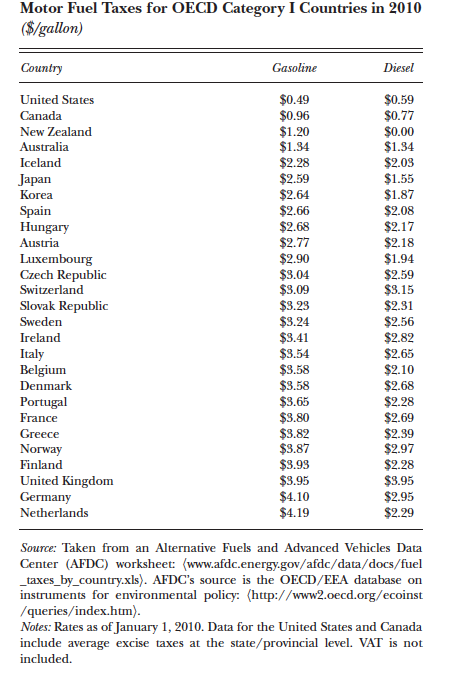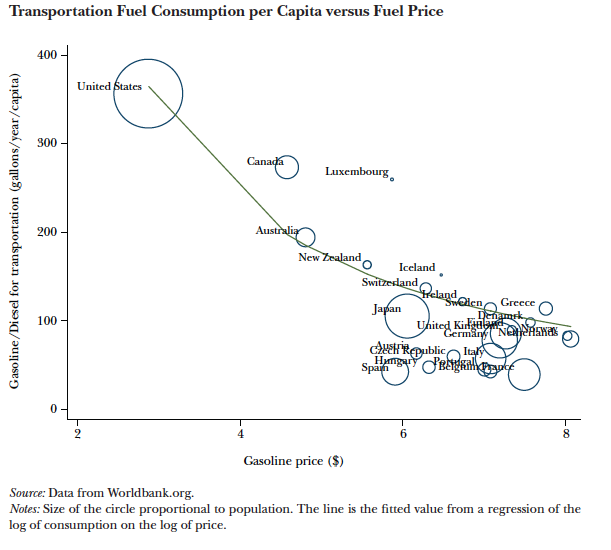In the following blog entry, I am going to compare and contrast several approaches to reduce the omission of carbon dioxide on the road in the US. These policies include the Corporate Average Fuel Economy (CAFE) standards, the Renewable Fuel Standard, the alternatives to the internal combustion engine, the reduction in vehicle miles traveled and the highly debated gasoline tax. I will base my explanations on the papers “Reducing Petroleum Consumption from Transportation” written by MIT professor Christopher Knittel in 2012 and “Estimating the Effect of a Gasoline Tax on Carbon Emissions” by Lucas W. Davis and Lutz Kilian in 2011. I will conclude with why the most fundamental way (a carbon tax) to combat the negative externality could be the most desirable of all.
Some background information
The Americans use more petroleum-based fuel per person than all other OECD-high-income countries. Research had shown that the US consumed 30 percent more than the second-highest country (Canada) and 40 percent more than the third highest (Luxemburg). The transportation sector accounts for 33.8 percent of the carbon dioxide emissions as stated by the US Department of Energy in ‘Energy Outlook 2008’. Hence, it is imperative to decrease the level of consumption of petroleum-based liquid fuel due to the negative externalities associated. However, due to the mesh of politics complicacy in the US, carbon tax is a political hot button and a high carbon tax is infeasible. We can see from the table below that the gasoline tax in the US is the lowest among the “OECD Category I countries” (the world’s most developed countries).
We also can infer from the graph below that per capita petroleum based liquid fuel consumption are strongly correlated with the gasoline price in the country (countries with low fuel prices have high fuel consumptions).
One thing to note here is that the regression line has already taken population size into account (the size of the bubbles is proportional to population) but the line looks similar even if it is not weighted. As a result, the US came up with some channels other than a heavy gasoline tax to reduce US oil consumption.
1. Corporate Average Fuel Economy (CAFE)
The CAFE standards set minimum par fuel economy thresholds for new automobiles sold by a car seller in a certain year and was established right after the oil price shocks in the 1970s. However, the standards are not so stringent over the years (barely budged to be precise). For example, the rule increased by just 0.5 miles per gallon (MPG) for passenger cars and the increase was only 3.5 MPG for light-duty trucks from 1984 to 2010. This is testified by the estimates from the World Bank whereby the EU standard was roughly 17MPG more aggressive in 2010 than the US standard. In addition, sport-utility vehicles and large pickup trucks were exempted from CAFE standards (SUVs and heavy vehicles are the most fuel inefficient ones). Although new policy has taken place to set a brand new vehicle fuel economy of 34.1 MPG in 2016 and 54.5 MPG in 2025, the par was drawn a little higher than the pace of technology progress. Therefore, the improved fuel economy such as CAFE had little effect in reducing gasoline consumption. In addition, reductions in weight and engine power coupled with massive technological advances had to take place to meet the new fuel economy target.
2. Alternative Fuels
Ethanol is an imperfect substitute for gasoline while biodiesel is a brilliant substitute for petroleum-based diesel. However, lifecycle analyses imply that corn-based ethanol may only play a slight role in reducing greenhouse gas emissions from the transportation sector. In addition, large-scale expansion of corn-based ethanol production needs additional land, which could cause distort optimal farmland usage. Furthermore, as we all learned in FRE501, corn-based biofuels compete with other uses of corn and would alter the world price of corn and its close substitutes. The most critical problem that limited large-scale substitution of ethanol for gasoline in the short run is due to the “blend wall” (the percentage of ethanol safely burned in a vehicle made to use gasoline only).
3. Replacing the Internal Combustion Engine
By powering vehicles with electricity or hydrogen definitely reduce pollution on the road. However, the cost is the hurdle to this seemingly viable and green solution. Simply put, it is way too expensive to replace the internal combustion engine and let the cars to run on electricity or hydrogen.
4. Reductions in the Miles Traveled
The US energy policies greatly underutilized this solution to combat carbon dioxide omissions on the road because of the reluctance of policymakers to adopt taxes to decrease petroleum consumption.
Since the first three solutions may not be working very well, let’s turn to the most basic way to tackle a negative externality, which is a tax. Davis and Kilian (2011) came up with a paper to evaluate the effectiveness of a gasoline tax raise by addressing the endogeneity of the gasoline prices, accounted for of the fact that the reduction to gasoline consumption due to a change in tax is different from the reduction of consumption due to an average change in price. By adopting various econometrical methods, they found a significant gasoline price elasticity of -0.46, which is much more than the existing literatures. This result implies that a 10 cent gasoline tax increase would decrease emissions by 0.48%. This is a breakthrough in the literatures because price elasticity of gasoline is usually to be close to zero (price inelastic). In addition, the plain way used to explain why tax is the efficient way to combat emissions is that by using basic economic knowledge, we know that performance standards is used as an implicit tax and subsidy program. Any product that is superior than the standard is implicitly subsidized while any product that is inferior than the standard is implicitly taxed. If we adopt the Renewable Fuel Standard policy (an implicit subsidy for “greener” fuels but still emit greenhouse gases), there will be a wedge between the Renewable Fuel Standard and the efficient policy, which is undesirable. Hence, I argue that the US government should increase gasoline tax despite the political complications.
References:
http://web.mit.edu/knittel/www/papers/JEP_latest.pdf
http://www.nber.org/papers/w14685.pdf?new_window=1

